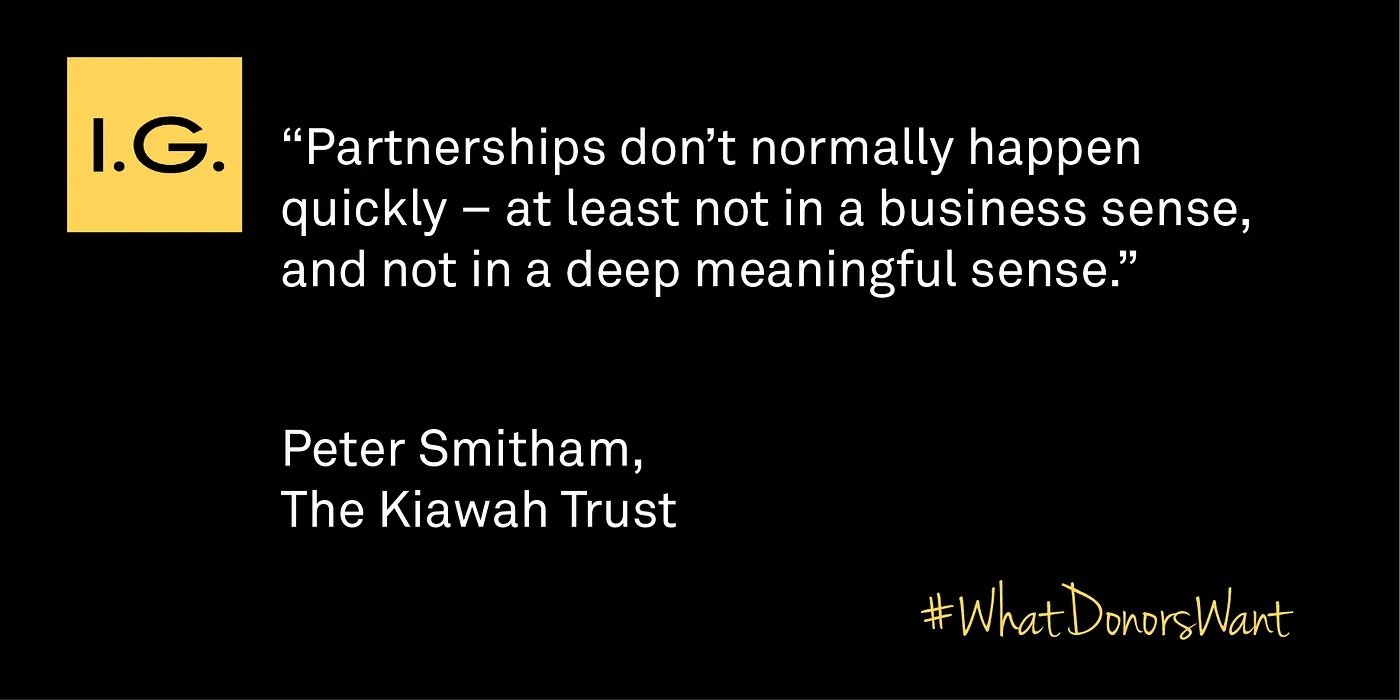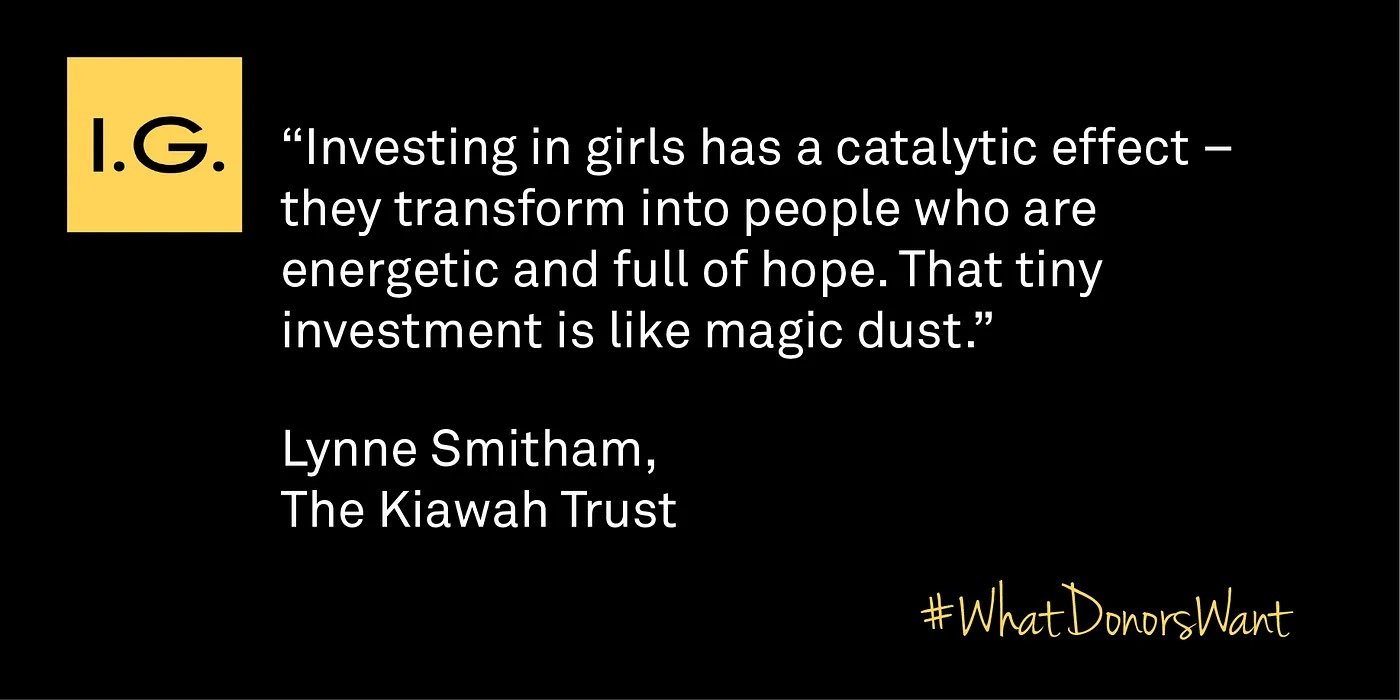What Donors Want — Episode # 2: Lynne & Peter Smitham, The Kiawah Trust
What Donors Want — a podcast by I.G. Advisors — offers a behind-the-scenes view into major gifts fundraising from the donor’s perspective.
After an incredible first foray into the world of podcasting, What Donors Want is back with a second episode.
For those of you who haven’t listened yet, What Donors Want is a podcast by I.G. Advisors, which offers a fresh, dynamic (and slightly irreverent) view into major gifts fundraising from the donor’s perspective. Each episode we interview a different kind of major donor and get right down to it: what do they actually want from the fundraisers who cultivate them. All of this and more — straight from the donor’s mouth.
Our first episode featured the brilliant Alfonsina Peñaloza, a Programme Officer at the Hewlett Foundation in California. And now our second episode features a dynamic philanthropic couple: Lynne and Peter Smitham who co-founded the Kiawah Trust in 2004.
Private trusts are tricky to tackle, as they rarely have transparent fundraising guidelines. Unlike large foundations, where you can quickly search grant history and relevant programme officers to connect with, cultivating a private trust requires meticulous network mapping and a highly bespoke approach.
Personal introduction and understanding counts
Take Lynne and Peter for example. In our interview, they speak about the importance of a personal introduction, and how critical it is that the fundraiser approaching them deeply understands their personal and philanthropic interests.
They have seen it all. Peter, a 30-year financial services executive, has received proposals without a single number in them. Lynne has gone to meetings where the senior staff member doesn’t let the junior staff member speak (even though they have brought them along to the meeting). They’ve been to pitch meetings where there is no presentation and the fundraiser can’t articulate what the charity actually does.

An unusual request from a funder
But they’ve also seen the best of it through their partnership with Dasra, one of India’s leading foundations focused on strategic philanthropy. Back in 2004, the Smithams made an unusual request, which was to fund an entirely new team and project within Dasra to focus exclusively and specifically on adolescent girls.
Recognising that supporting girls was the key to disrupting the poverty cycle, they launched this partnership through a $2 million unrestricted gift, which was leveraged as an anchor donation to raise tens of millions for girls and create what is now known as the Dasra Girls Alliance. How did Dasra manage to secure this level of robust, flexible support from Lynne and Peter for a completely new programme? Well — you’ll have to listen to find out.

As funders, Lynne and Peter have struck a brilliant balance of being both hands-on and hands-off. They deeply engage in the cause and bring other partners to the table — but they also trust their partners to be the experts and spend the funds most effectively. It’s because of this fresh approach that they are featured as a best practice case study in our inaugural I.G. Insights report, The State of Funding for Girls, written by I.G.’s Managing Director, Alisha Miranda.
You can hear the entire conversation between me, Alisha, Lynne and Peter by subscribing to What Donors Want on iTunes.
I.G. Advisors bridges the gap between fundraisers, corporates and philanthropists to maximise impact. We provide strategic advice to both charities and donors, advising charities on how to fundraise effectively, and advising donors on how to create the most impact with their resources. If you’d like to find out more about how we can support you, please get in touch or visit impactandgrowth.com for more information.
Originally published at fundraising.co.uk on September 7, 2017.
As we close the chapter on 2024 and step into a new year, our Advisor, Harriette, finds herself reflecting on what’s needed to move philanthropy forward in 2025.
It’s not a groundbreaking revelation that staff wellbeing and burnout are huge challenges our sector is facing right now, and the sector-wide lack of investment in professional development has a lot to answer for.
Our Associate Advisor Charly makes the case that greater investment in your grantmaking team = greater impact for your organisation, and beyond.
While philanthropy and football may seem worlds apart, I’ve started thinking about the many similarities that can provide valuable lessons for those in the philanthropic sector. I for one, am always learning about the essential elements of football that can inspire and inform effective philanthropy.
Through the power of collective design, our fundraiser and grantmaker #FixTheFlow Fellows have imagined the future of our philanthropic funding system, and we should all listen carefully.
In the coming months, our Associate Carli is exploring the complexities of social innovation and will share her learnings, insights, and questions with you.
I.G.’s CEO Emily shares some of the mistakes and challenges she found during her leadership journey, and what she learned and will share in I.G.’s new Leadership Lab.
I’m expected to show up as a leader, but don’t feel like a leader. Introducing Impact & Grow: A Leadership Lab.
Leveraging Limited Funds For Humanitarians: Insights from the 2024 #HX24 conference, organised by Save the Children UK and the Humanitarian Leadership Academy.
Social enterprises have a particularly interesting relationship with Monitoring, Evaluation and Learning (MEL) as they need to capture both the financial and social/ environmental impact of their work, and speak to a wide range of potential funders and investors. Caitlin McLoughlin chatted to Abhinav Khanal, Co-Founder and Executive Director of Bean Voyage, to explore this further.
Image Credit: Bean Voyage
A round up of everything the I.G. team did in 2023!
Introducing a new, dedicated funders stream to I.G.’s #FixTheFlow Fellowship! We’re accepting applications until 17th November (for a 2024 start). Join our movement at fixtheflow.org
Join us for one (or all!) our eight workshops in our Autumn Training Series, where we will cover some of the trickiest topics facing fundraisers today.
What does meaningful and effective learning actually mean in practice?
Our Advisor Caitlin interviews Kore Global’s Emily Boost on learning how to learn and all things feminist evaluation and learning.
How do we balance our passion and our desire to give our best, whilst not being consumed by failure to live up to our own or others’ expectations?
At I.G. Advisors (I.G.), we’re often approached to design and implement evaluations for our clients to understand the impact of their grantmaking, fundraising or programmatic strategies, and identify opportunities for evolution.
The ‘lone saviour’ approach won’t cut it (and it also might destroy you).
It’s hard to believe it now that we’re living through a polycrisis, but the financial crisis and Great Recession of the 00s felt like a once-in-a-lifetime jolt to the world order at the time.
What you can learn from others leading philanthropic networks like yours
‘Well, we could have called that one.’
I.G. Advisors (I.G.) recently had the pleasure of collaborating with The Big Give and Rosa on the Women and Girls Match Fund.
Being a parent is often a thankless task. You take something and nurture it, treating it with love and care, losing sleep and worrying if — against all odds — , it will achieve its full potential and become the best it can be. It may never, ever show gratitude for your sacrifice. And then one day it will grow up and leave.
New I.G. Insights report explores how fundraisers and funders can support digital fundraising for racial justice issues.
#TaxPhilanthropy — wealth holders have the power to pay more tax right now even if governments fail to reform their policies
How starting small might be the most effective way to change the world.
An insight into “Modern Grantmaking: A Guide for Funders Who Believe Better is Possible”
A couple of weeks ago, I.G. brought back its much-loved book club event for our first in-person get together in over a year.
Podcast listeners — a new episode of What Donors Want is out! We had the honour of speaking with David Simas, CEO of the Obama Foundation.
Senior Social Impact Advisor (I.G. Advisors & Lightful)






























